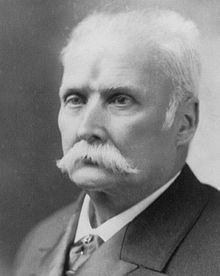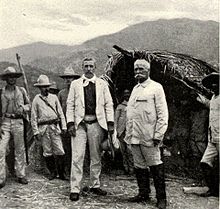Calixto García

Calixto García Íñiguez (August 4, 1839 – December 11, 1898) was a
Ancestry and progeny
García was born in
War record
Around the age of 28, taking after his grandfather, García joined with a Cuban uprising which became the first war of independence (

Garcia had a long string of victories in this war, which included the taking of Tunas and Guisa, and the emotionally significant re-occupation of Bayamo. García made liberal use of spies to prepare for his attacks. These include Dominador de la Guardia father of Ángel de la Guardia and María Machado, illegitimate daughter of Spanish General Emilio March who helped prepare the taking of Tunas; Frederick Funston later US Major General and José Martí y Zayas Bazán son of José Martí the major Cuban National Hero directed artillery; Mario García Menocal a to-be president of Cuba who was wounded in a principal assault. Angel de la Guardia, also a major Cuban national hero, died in this battle on August 30, 1897.[3]
At the time of the U.S. landings, García, with skilled use of mobile artillery, controlled the interior of old Oriente Province, and prepared the landing places for the U.S. Army near Santiago. His troops effectively supported the Marine forces at Guantanamo who, once out of range of the guns of the USS Marblehead, had difficulty dealing with Spanish guerrilla tactics. He was the general who dealt with the American troops and joined them in military actions, only to be denied entrance into Santiago de Cuba when the Spanish surrendered.
Death
García died of pneumonia at the age of 59 on December 11, 1898, one day after the end of the Spanish–American War, while on a diplomatic mission in
The essay "
In 1976, a municipality in Holguín Province was named Calixto García after him. His portrait is on the 50 Cuban peso banknote.
Print sources
- Castellano García, Gerardo 1927. Tierras y Glorias de Oriente (Calixto García Iñiguez) Editorial Hermes Havana
- Escalante Beaton, Anibal 1946. Calixto García Su Campaña en el 95. Arrow Press Havana. (Introduction by General Carlos García Velez, son of the mayor general and a firsthand witness to many of the events described.)
- Rice, Donald Tunnicliff, 2016. Cast in Deathless Bronze: Andrew Rowan, The Spanish–American War, and the Origins of American Empire. Morgantown: West Virginia University Press. (This volume contains more information regarding García's life and career than any other English-language publication.)
References
- ^ "Palabras de tres guerras". Instituto Civico Militar. 1942.
- ^ "Generals of the Cuban Army of Liberation". www.cubagenweb.org. Retrieved March 22, 2019.
- ^ a b (in Spanish) Article Archived January 16, 2006, at the Wayback Machine on Granma
- ^ "Enamorado". www.spanamwar.com. Retrieved March 22, 2019.
- ^ "Infos on the Naval Historical Centre website". Retrieved March 22, 2019.
- ^ "Log In ‹ Home of Heroes — WordPress". homeofheroes.com. Retrieved March 22, 2019.
- ^ Info at cubatravels.net
External links
 Media related to Calixto García at Wikimedia Commons
Media related to Calixto García at Wikimedia Commons- Calixto García at Find a Grave
- . . 1914.

